The Effect of Intramolecular Hydrogen Bond Type on the Gas-Phase Deprotonation of ortho-Substituted Benzenesulfonic Acids. A Density Functional Theory Study
Abstract
1. Introduction
2. Calculation Details
3. Conformational Diversity of ortho-Substituted BSA Molecules
4. The Conformers Structure of Molecules of ortho-Substituted BSA
5. Structure of Deprotonated Forms of ortho-Substituted BSA
6. Influence of IHB on ΔrG0298Gas-Phase Deprotonation Value of Different Conformers of ortho-Substituted BSA
7. The Effect of the X Substituent Nature on the ΔrG0298 Values
8. Features of 2-SO3H-BSA Deprotonation: The Influence of IHB on Proton Donor Properties of Diacid
9. Conclusions
Supplementary Materials
Author Contributions
Funding
Conflicts of Interest
References
- Viggiano, A.A.; Henchman, M.J.; Dale, F.; Deakyne, C.A.; Paulson, J.F. Gas-Phase Reactions of Weak Bronsted Bases I–, PO3–, HSO4–, FSO3–, and CF3SO3– with Strong Bronsted Acids H2SO4, FSO3H, and CF3SO3H. A Quantitative Intrinsic Superacidity Scale for the Sulfonic Acids XSO3H (X = HO, F, and CF3). J. Am. Chem. Soc. 1992, 114, 4299–4306. [Google Scholar] [CrossRef]
- Koppel, I.A.; Taft, R.W. The Gas-Phase Acidities of Very Strong Neutral Bronsted Acids. J. Am. Chem. Soc. 1994, 116, 3047–3057. [Google Scholar] [CrossRef]
- Ervin, K.M.; DeTuri, V.F. Anchoring the Gas-Phase Acidity Scale. J. Phys. Chem. A 2002, 106, 9947–9956. [Google Scholar] [CrossRef]
- Gutowski, K.E.; Dixon, D.A. Ab Initio Prediction of the Gas- and Solution-Phase Acidities of Strong Brønsted Acids: The Calculation of pKa Values Less Than-10. J. Phys. Chem. A 2006, 110, 12044–12054. [Google Scholar] [CrossRef] [PubMed]
- Ho, J.; Coote, M.L. First-principles prediction of acidities in the gas and solution phase. Wiley Interdiscip. Rev. Comput. Mol. Sci. 2011, 1, 649–660. [Google Scholar] [CrossRef]
- Raamat, E.; Kaupmees, K.; Ovsjannikov, G.; Trummal, A.; Kutt, A.; Saame, J.; Koppel, I.; Kaljurand, I.; Lipping, L.; Rodima, T.; et al. Acidities of strong neutral Brønsted acids in different media. J. Phys. Org. Chem. 2012, 26, 162–170. [Google Scholar] [CrossRef]
- Trummal, A.; Lipping, L.; Kaljurand, I.; Koppel, I.A.; Leito, I. Acidity of Strong Acids in Water and Dimethyl Sulfoxide. J. Phys. Chem. A 2016, 120, 3663–3669. [Google Scholar] [CrossRef]
- Valadbeigi, Y.; Vianello, R. A density functional theory study on the superacidity of sulfuric, fluorosulfuric, and triflic acid derivatives with two cyclopentadiene rings: Ion pairs formation in the gas phase. J. Phys. Org. Chem. 2019, 32, e3995. [Google Scholar] [CrossRef]
- Siril, P.F.; Davison, A.D.; Randhawa, J.K.; Brown, D.R. Acid strengths and catalytic activities of sulfonic acid on polymeric and silica supports. J. Mol. Catal. A Chem. 2007, 267, 72–78. [Google Scholar] [CrossRef]
- Mauder, D.; Akcakayiran, D.; Lesnichin, S.B.; Findenegg, G.H.; Shenderovich, I.G. Acidity of Sulfonic and Phosphonic Acid-Functionalized SBA-15 under Almost Water-Free Conditions. J. Phys. Chem. C 2009, 113, 19185–19192. [Google Scholar] [CrossRef]
- Galabov, G.B.; Nalbantova, D.; Schleyer, P.R.; Schaefer, H.F. Electrophilic Aromatic Substitution: New Insights into an Old Class of Reactions. Acc. Chem. Res. 2016, 49, 1191–1199. [Google Scholar] [CrossRef] [PubMed]
- Kozlov, V.A.; Ivanov, S.N.; Koifman, O.I. Solvated proton as the main reagent and a catalyst in the single-stage aromatic sulfonation and protodesulfonation of sulfonic acids. J. Phys. Org. Chem. 2017, 29, 1–29. [Google Scholar] [CrossRef]
- Paddison, S.J.; Elliott, J.A. The effects of backbone conformation on hydration and proton transfer in the ‘short-side-chain’ perfluorosulfonic acid membrane. Solid State Ion. 2006, 177, 2385–2390. [Google Scholar] [CrossRef]
- Chang, Y.; Brunello, G.F.; Fuller, J.; Hawley, M.; Kim, Y.S.; Disabb-Miller, M.; Hickner, M.A.; Jang, S.S.; Bae, C. Aromatic Ionomers with Highly Acidic Sulfonate Groups: Acidity, Hydration, and Proton Conductivity. Macromolecules 2011, 44, 8458–8469. [Google Scholar] [CrossRef]
- Sakai, H.; Tokumasu, T. Quantum chemical analysis of the deprotonation of sulfonic acid in a hydrocarbon membrane model at low hydration levels. Solid StateIon. 2015, 274, 94–99. [Google Scholar] [CrossRef]
- Shimoaka, T.; Wakai, C.; Sakabe, T.; Yamazakib, S.; Hasegawa, T. Hydration structure of strongly bound water on the sulfonic acid group in a Nafion membrane studied by infrared spectroscopy and quantum chemical calculation. Phys. Chem. Chem. Phys. 2015, 17, 8843–8849. [Google Scholar] [CrossRef]
- Kuo, A.; Shinoda, W.; Okazaki, S. Molecular Dynamics Study of the Morphology of Hydrated Perfluorosulfonic Acid Polymer Membranes. J. Phys. Chem. C 2016, 120, 25832–25842. [Google Scholar] [CrossRef]
- Berlinger, S.A.; McCloskey, B.D.; Weber, A.Z. Inherent Acidity of Perfluoro-sulfonic Acid Ionomer Dispersions and Implications for Ink Aggregation. J. Phys. Chem. B 2018, 122, 7790–7796. [Google Scholar] [CrossRef]
- Savage, J.; Tse, Y.-L.S.; Voth, G.A. Proton Transport Mechanism of Perfluorosulfonic Acid Membranes. J. Phys. Chem. C 2014, 118, 17436–17445. [Google Scholar] [CrossRef]
- Thomaz, J.E.; Lawler, C.M.; Fayer, M.D. Proton Transfer in Perfluorosulfonic Acid Fuel Cell Membranes with Differing Pendant Chains and Equivalent Weights. J. Phys. Chem. B 2017, 121, 4544–4553. [Google Scholar] [CrossRef]
- Kusoglu, A.; Weber, A.Z. New Insights into Perfluorinated Sulfonic-Acid Ionomers. Chem. Rev. 2017, 117, 987–1104. [Google Scholar] [CrossRef] [PubMed]
- Mabuchi, T.; Tokumasu, T. Relationship between Proton Transport and Morphology of Perfluorosulfonic Acid Membranes: A Reactive Molecular Dynamics Approach. J. Phys. Chem. B 2018, 122, 5922–5932. [Google Scholar] [CrossRef] [PubMed]
- Gruzdev, M.S.; Shmukler, L.E.; Kudryakova, N.O.; Kolker, A.M.; Sergeeva, Y.A.; Safonova, L.P. Triethanolamine-based protic ionic liquids with various sulfonic acids: Synthesis and properties. J. Mol. Liq. 2017, 242, 838–844. [Google Scholar] [CrossRef]
- Dupont, D.; Raiguel, S.; Binnemansa, K. Sulfonic acid functionalized ionic liquids for dissolution of metal oxides and solvent extraction of metal ions. Chem. Commun. 2015, 51, 9006–9009. [Google Scholar] [CrossRef] [PubMed]
- Shan, W.; Yang, Q.; Su, B.; Bao, Z.; Ren, Q.; Xing, H. Proton Microenvironment and Interfacial Structure of Sulfonic-Acid-Functionalized Ionic Liquids. J. Phys. Chem. C 2015, 119, 20379–20388. [Google Scholar] [CrossRef]
- Ren, J. Polar Group Enhanced Gas-Phase Acidities of Carboxylic Acids: An Investigation of Intramolecular Electrostatic Interaction. J. Phys. Chem. A 2006, 110, 13405–13411. [Google Scholar] [CrossRef] [PubMed]
- Estácio, S.G.; Cabral do Couto, P.; Costa Cabral, B.J.; Minas da Piedade, M.E.; MartinhoSimões, J.A. Energetics of Intramolecular Hydrogen Bonding in Di-substituted Benzenes by the ortho-para Method. J. Phys. Chem. A 2004, 108, 10834–10843. [Google Scholar] [CrossRef]
- Krygowski, T.M.; Zachara-Horeglad, J.E. Resonance-assisted hydrogen bonding in terms of substituent effect. Tetrahedron 2009, 65, 2010–2014. [Google Scholar] [CrossRef]
- Gilli, P.; Pretto, L.; Bertolasi, V.; Gilli, G. Predicting Hydrogen-Bond Strengths from Acid-Base Molecular Properties. The pKa Slide Rule: Toward the Solution of a Long-Lasting Problem. Acc. Chem. Res. 2009, 42, 33–44. [Google Scholar] [CrossRef]
- Pisareva, A.V.; Shilov, G.V.; Karelin, A.I.; Dobrovolsky, Y.A. The Structure and Properties of Phenol-2,4-disulfonic Acid Dihydrate. Russ. J. Phys. Chem. A 2008, 82, 355–363. [Google Scholar] [CrossRef]
- Pisareva, A.V.; Shilov, G.V.; Karelin, A.I.; Dobrovolsky, Y.A.; Pisarev, R.V. 2-Hydroxy-4-methylbenzenesulfonic acid dihydrate: Crystal structure, vibrational spectra, proton conductivity, and thermal stability. Russ. J. Phys. Chem. A 2010, 84, 444–459. [Google Scholar] [CrossRef]
- Pisareva, A.V.; Pisarev, R.V.; Karelin, A.I.; Dobrovol’skii, Y.A. Proton conductivity of benzoic and 2-sulfobenzoic acids. Russ. J. Electrochem. 2013, 49, 794–800. [Google Scholar] [CrossRef]
- Shmygleva, L.V.; Slesarenko, N.; Chernyak, A.; Sanginov, E.; Karelin, A.; Pisareva, A.; Pisarev, R.; Dobrovolsky, Y. Effect of Calixarene Sulfonic Acids Hydration on Their Proton Transport Properties. Int. J. Electrochem. Sci. 2017, 12, 4056–4076. [Google Scholar] [CrossRef]
- Garanin, E.M.; Tolmachev, Y.V.; Bunge, S.D.; Khitrin, A.K.; Turanov, A.N.; Malkovskiy, A.; Sokolov, A.P. Fast protonic conductivity in crystalline benzenehexasulfonic acid hydrates. J. Solid State Electrochem. 2011, 15, 549–560. [Google Scholar] [CrossRef]
- Petrov, V.M.; Giricheva, N.I.; Ivanov, S.N.; Bardina, A.V.; Girichev, G.V.; Petrova, V.N. Gas Electron Diffraction and Quantum Chemical Studies of the Molecular Structure of 2-Nitrobenzenesulfonic Acid. J. Struct. Chem. 2011, 52, 60–68. [Google Scholar] [CrossRef]
- Giricheva, N.I.; Girichev, G.V.; Medvedeva, Y.S.; Ivanov, S.N.; Petrov, V.M. The influence of steric hindrance on conformation properties and molecular structure of 2,4,6-trinitrobenzenesulfonic acid: Gas electron diffraction and quantum chemical calculations. Struct. Chem. 2012, 23, 895–904. [Google Scholar] [CrossRef]
- Ivanov, S.N.; Giricheva, N.I.; Nurkevich, T.V.; Fedorov, M.S. Energies of the Gas-Phase Deprotonation of Nitro-Substituted Benzenesulfonic and Benzoic Acids: The Role of the Conformation Isomerism of Sulfonic Acids. Russ. J. Phys. Chem. A 2014, 88, 667–672. [Google Scholar] [CrossRef]
- Valadbeigi, Y.; Rouhani, M. Borane and beryllium derivatives of sulfuric and phosphoric acids: Strong inorganic acids. Comput. Theor. Chem. 2019, 1164, 112550. [Google Scholar] [CrossRef]
- McMahon, T.B.; Kebarle, P. Intrinsic acidities of substituted phenols and benzoic acids determined by gas-phase proton-transfer equilibriums. J. Am. Chem. Soc. 1977, 99, 2222–2230. [Google Scholar] [CrossRef]
- Koppel, I.A.; Burk, P.; Koppel, I.; Sonoda, T.; Mishima, M. Gas-Phase Acidities of Some Neutral Brønsted Superacids: A DFT and ab Initio Study. J. Am. Chem. Soc. 2000, 122, 5114–5124. [Google Scholar] [CrossRef]
- Shubin, L.; Schauer, C.K.; Pedersen, L.G. Molecular acidity: A quantitative conceptual density functional theory description. J. Chem. Phys. 2009, 131, 164107. [Google Scholar] [CrossRef]
- Giricheva, N.I.; Girichev, G.V.; Medvedeva, Y.S.; Ivanov, S.N.; Petrov, V.M.; Fedorov, M.S. Do enantiomers of benzenesulfonic acid exist? Electron diffraction and quantum chemical study of molecular structure of benzenesulfonic acid. J. Mol. Struct. 2012, 1023, 25–30. [Google Scholar] [CrossRef]
- Wiberg, K.B. Substituent Effects on the Acidity of Weak Acids. 2. Calculated Gas-Phase Acidities of Substituted Benzoic Acids. J. Org. Chem. 2002, 67, 4787–4794. [Google Scholar] [CrossRef] [PubMed]
- Bohm, S.; Fiedler, P.; Exner, O. Analysis of the ortho effect: Acidity of 2-substituted benzoic acids. New. J. Chem. 2004, 28, 67–74. [Google Scholar] [CrossRef]
- Fiedler, P.; Bohm, S.; Kulhanek, J.; Exner, O. Acidity of ortho-substituted benzoic acids: An infrared and theoretical study of the intramolecular hydrogen bonds. Org. Biomol. Chem. 2006, 4, 2003–2011. [Google Scholar] [CrossRef]
- Amador-Balderas, J.A.; Martínez-Sánchez, M.-A.; Ramírez, R.E.; Méndez, F.; Meléndez, F.J. Analysis of the Gas Phase Acidity of Substituted Benzoic Acids Using Density Functional Concepts. Molecules 2020, 25, 1631. [Google Scholar] [CrossRef]
- Woon, D.E.; Dunning, T.H. Gaussian basis sets for use in correlated molecular calculations. III. The atoms aluminum through argon. J. Chem. Phys. 1993, 98, 1358–1371. [Google Scholar] [CrossRef]
- Frisch, M.J.; Trucks, G.W.; Schlegel, H.B.; Scuseria, G.E.; Robb, M.A.; Cheeseman, J.R.; Scalmani, G.; Barone, V.; Petersson, G.A.; Nakatsuji, H.; et al. Gaussian 09; Gaussian: Wallingford, CT, USA, 2009. [Google Scholar]
- Giricheva, N.I.; Girichev, G.V.; Fedorov, M.S.; Ivanov, S.N. Substituent effect on geometric and electronic structure of benzenesulfonic acid: Gas-phase electron diffraction and quantum chemical studies of 4-CH3C6H4SO3H and 3-NO2C6H4SO3H molecules. Struct. Chem. 2013, 24, 807–818. [Google Scholar] [CrossRef]
- Giricheva, N.I.; Fedorov, M.S.; Girichev, G.V. Conformations of methylbenzenesulfonate and its substituted derivatives: Gas-phase electron diffraction versus vibrational spectroscopy. Struct. Chem. 2015, 26, 1543–1553. [Google Scholar] [CrossRef]
- Giricheva, N.I.; Fedorov, M.S.; Ivanov, S.N.; Girichev, G.V. The difference between gas-phase and crystal structures of ortho-nitromethylbenzenesulfonate. Conformation variety study of free molecules by electron diffraction and quantum chemistry. J. Mol. Struct. 2015, 1085, 191–197. [Google Scholar] [CrossRef]
- Reed, A.E.; Curtiss, L.A.; Weinhold, F. Intermolecular interactions from a natural bond orbital, donor-acceptor viewpoint. Chem. Rev. 1988, 88, 899–926. [Google Scholar] [CrossRef]
- Smirnova, N.A. Methods of Statistical Thermodynamics in Physical Chemistry; VysshayaShkola: Moscow, Russia, 1973. (In Russian) [Google Scholar]
- Arunan, E.; Desiraju, G.R.; Klein, R.A.; Sadlej, J.; Scheiner, S.; Alkorta, I.; Clary, D.C.; Crabtree, R.H.; Dannenberg, J.J.; Hobza, P.; et al. Defining the hydrogen bond. An account (IUPAC Technical Report). Pure Appl. Chem. 2011, 83, 1619–1636. [Google Scholar] [CrossRef]
- Giricheva, N.I.; Fedorov, M.S.; Shpilevaya, K.E.; Surbu, S.A.; Ditsina, O.Y. Characteristics of the hydrogen bond and the structure of H-complexes of p-n-propyloxybenzoic acid and p-n-propyloxy-p′-cyanobiphenyl. J. Struct. Chem. 2017, 58, 9–16. [Google Scholar] [CrossRef]
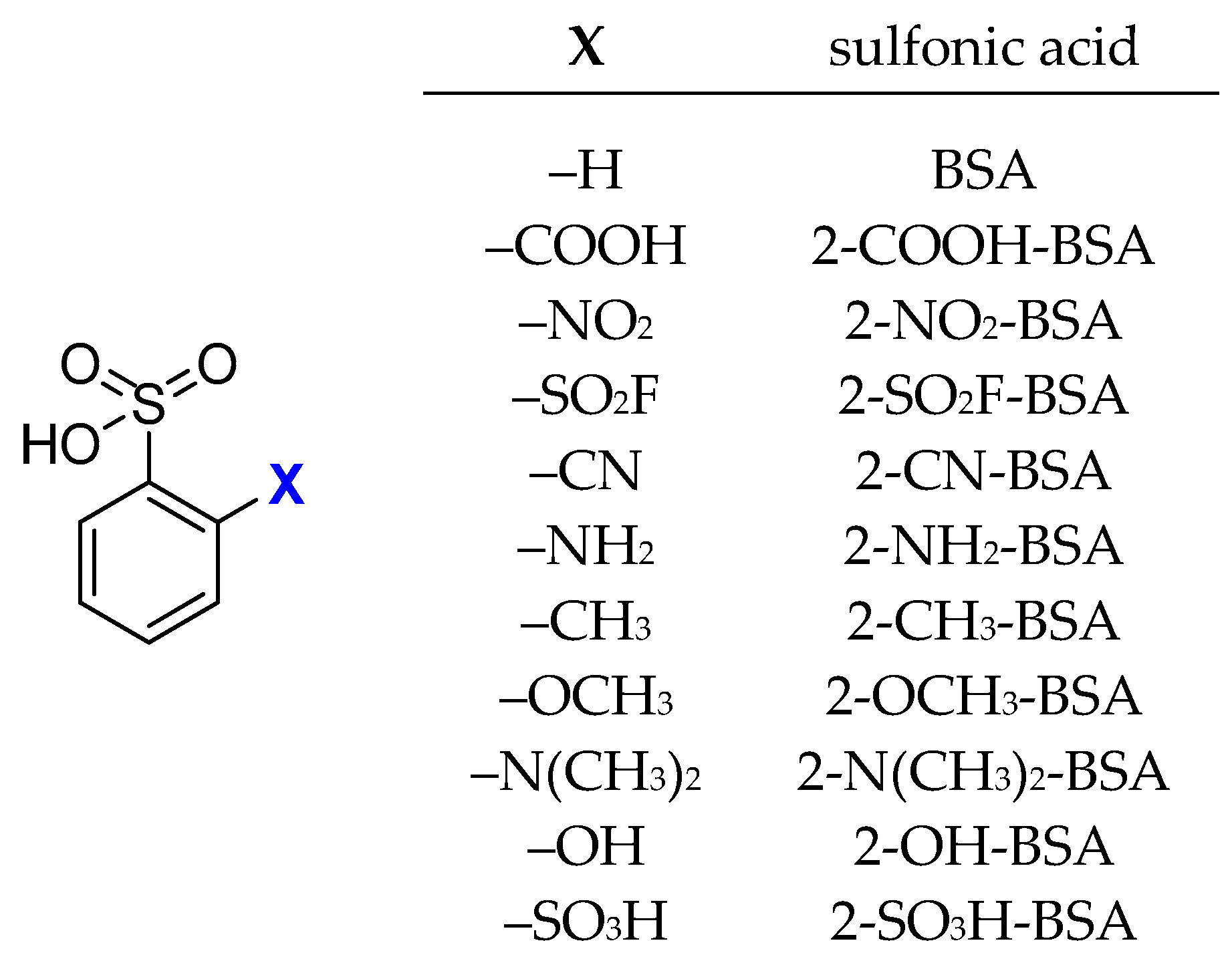
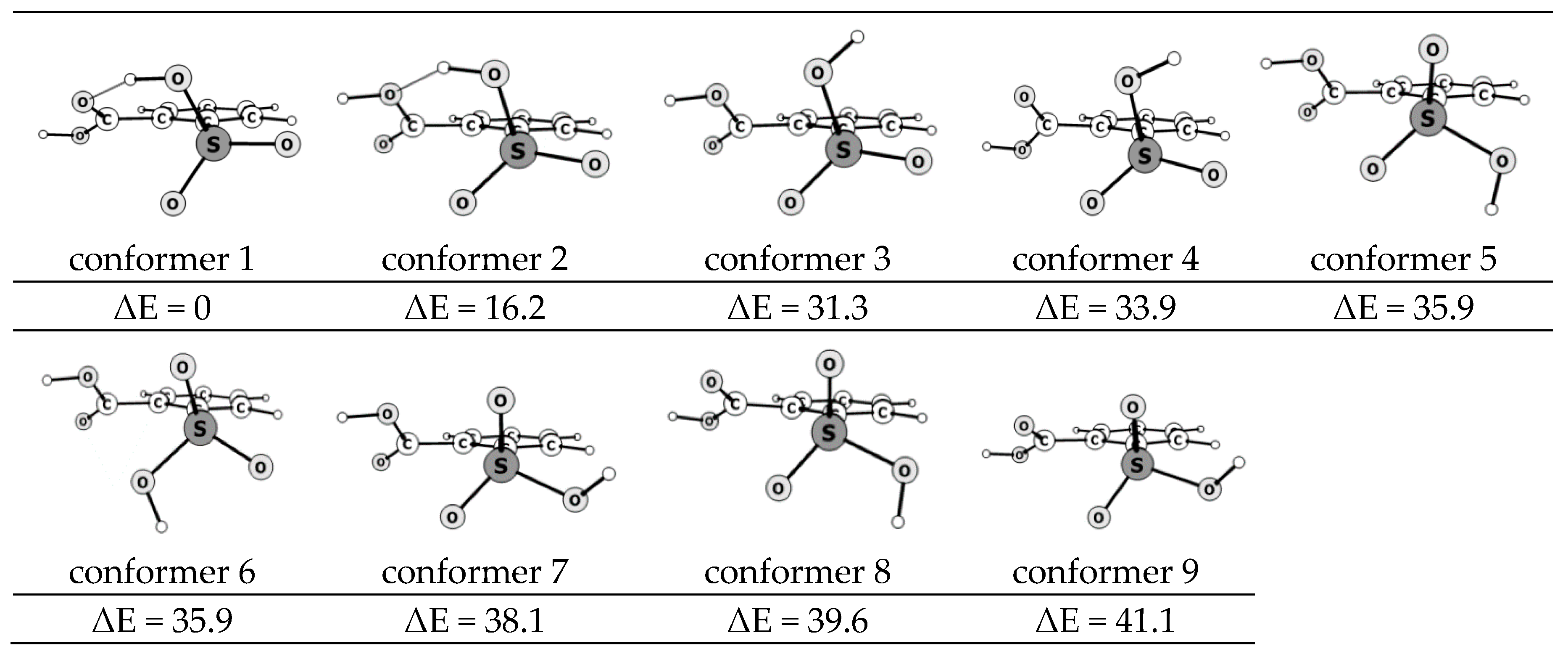

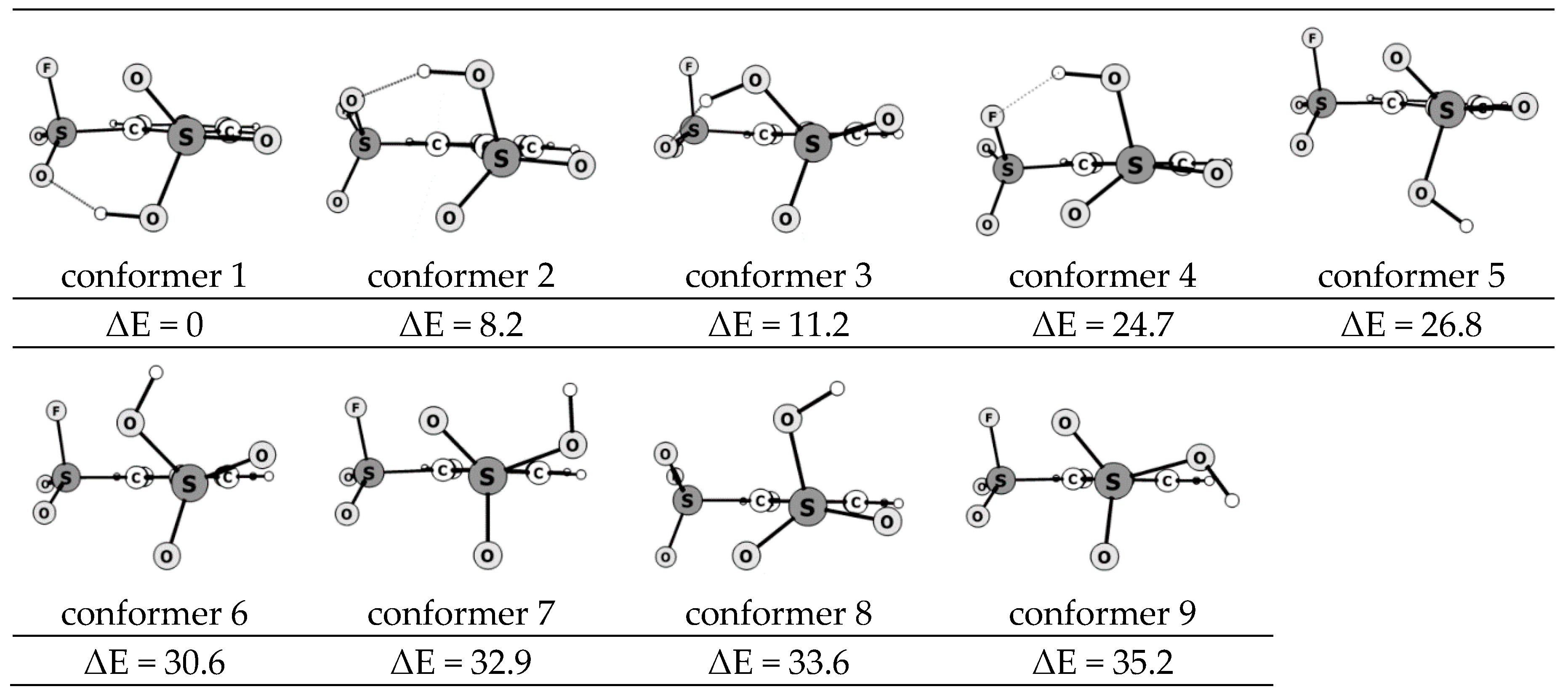

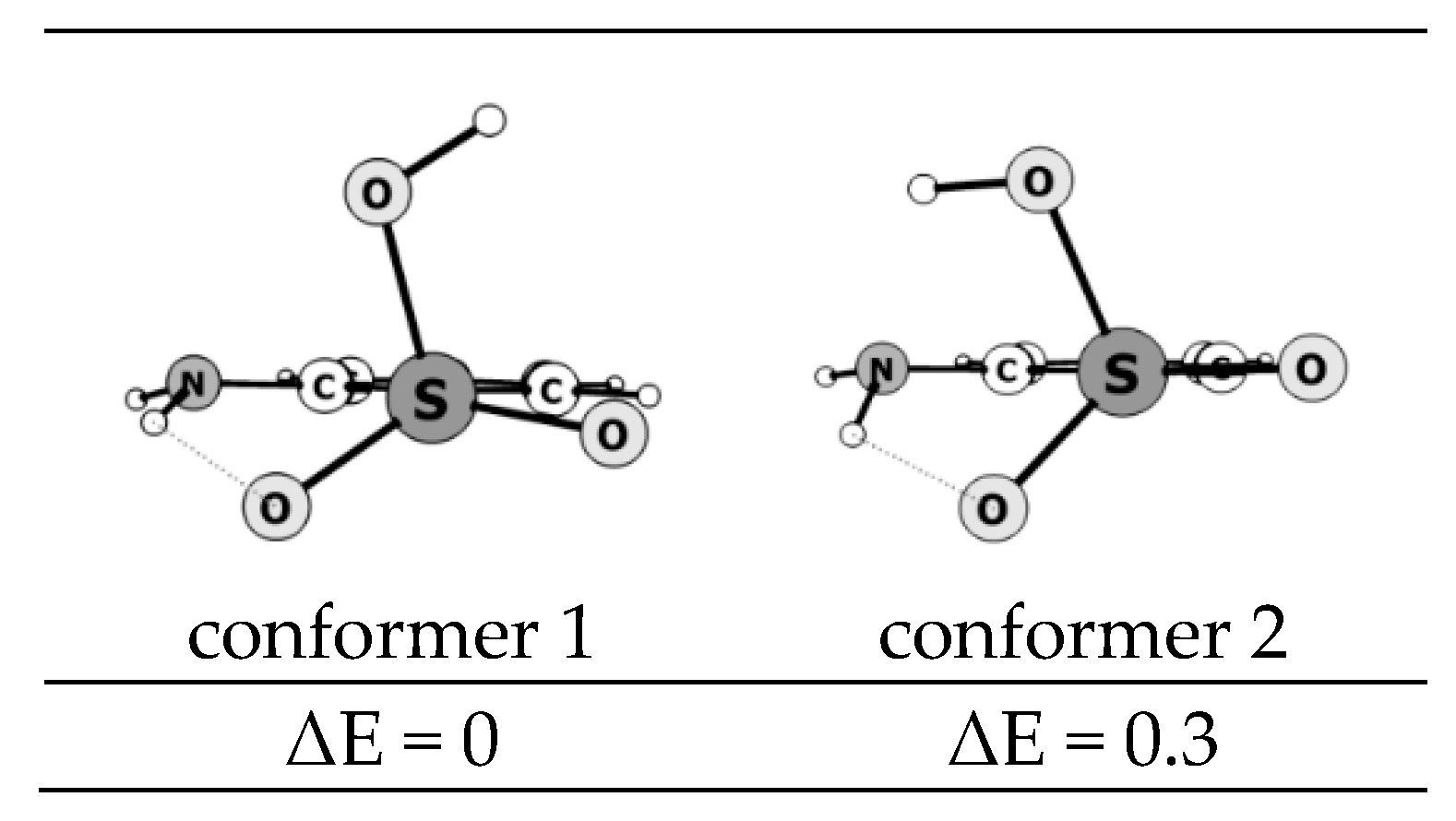
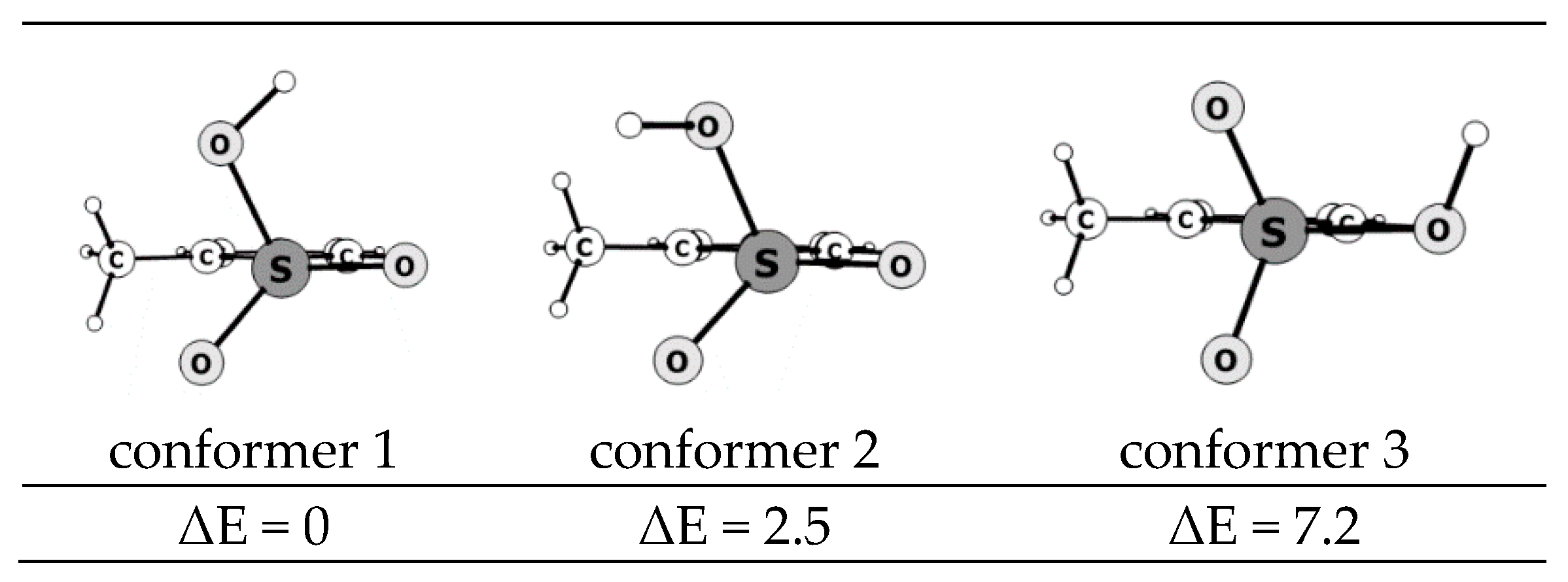



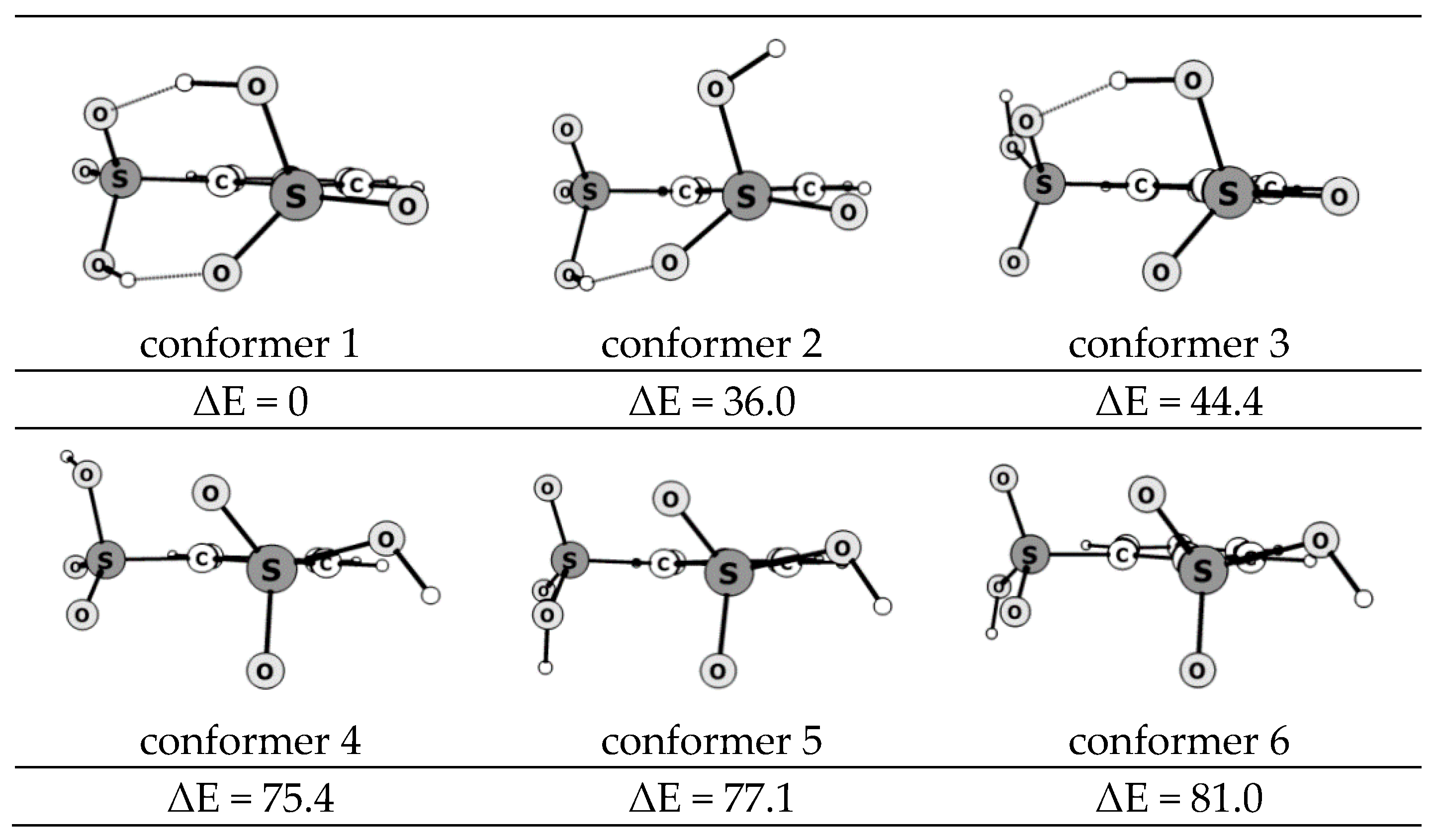
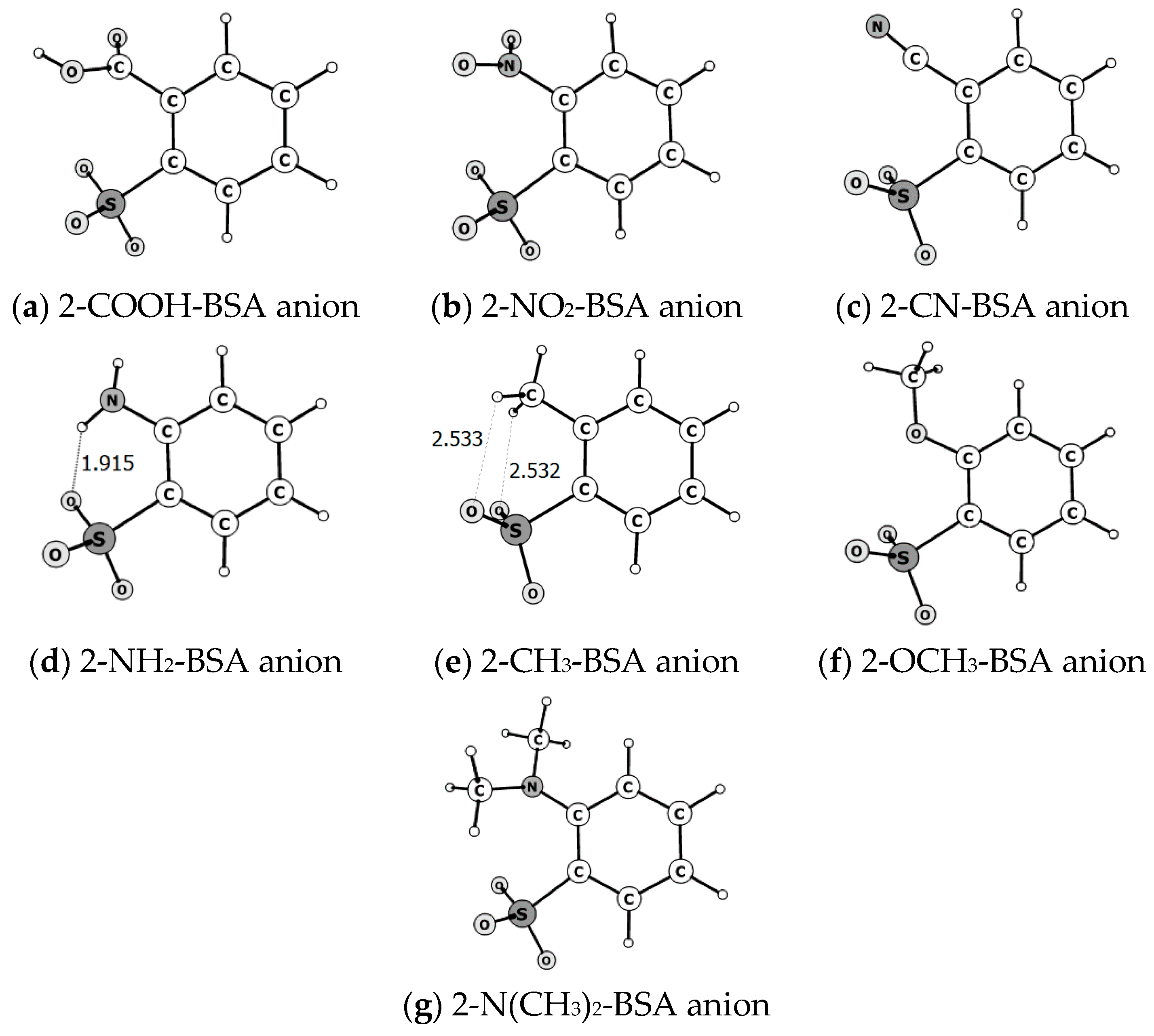
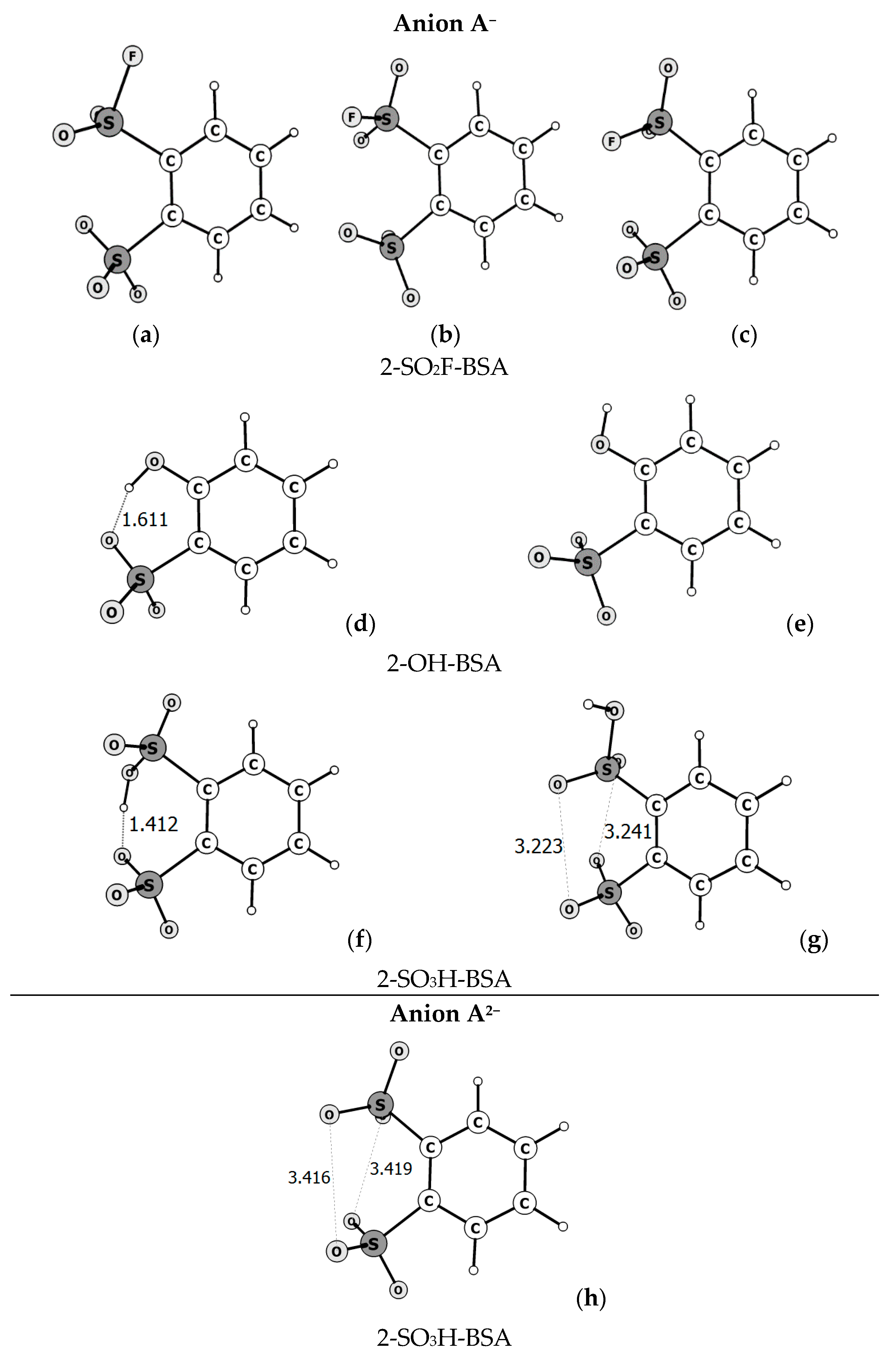
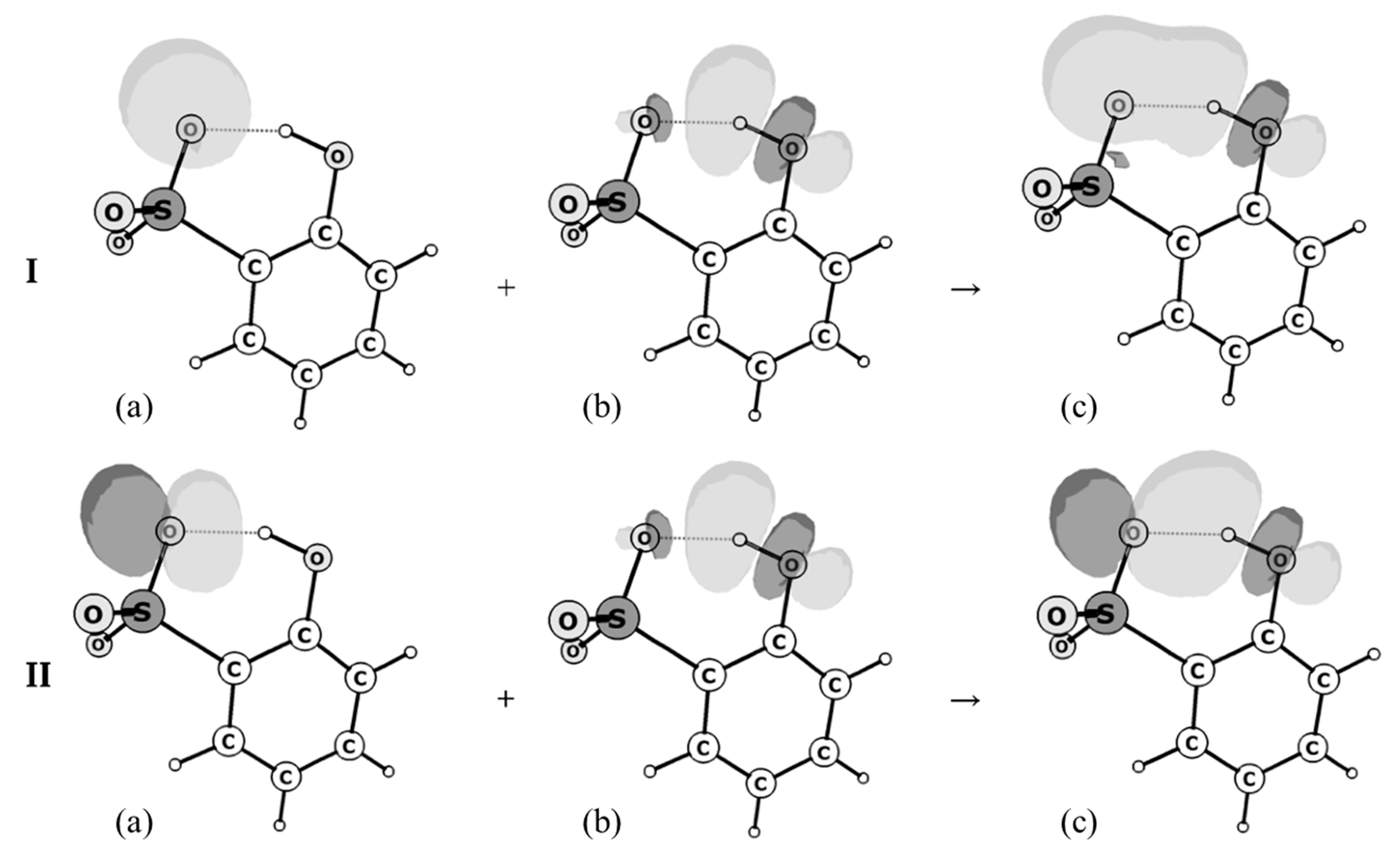
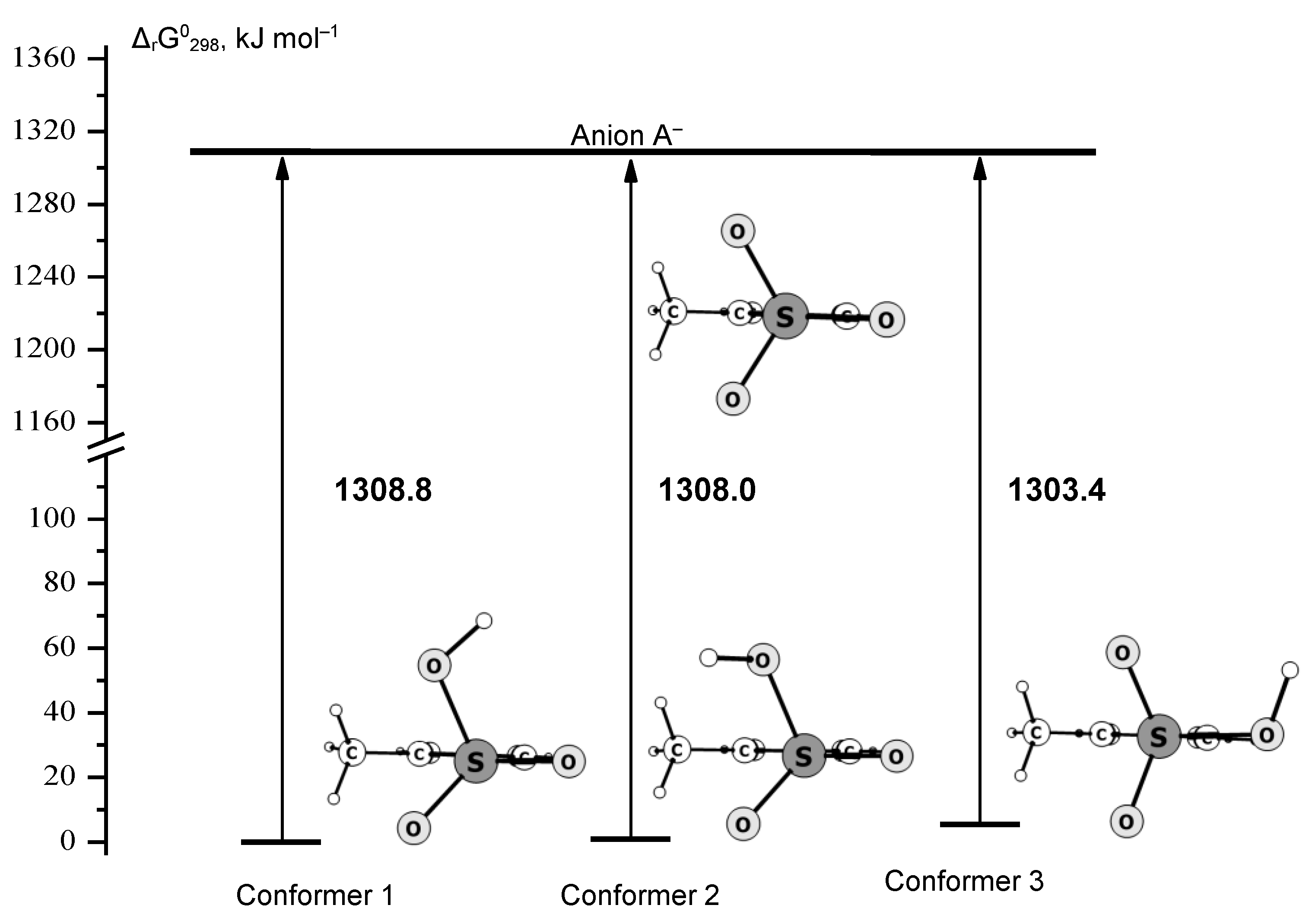
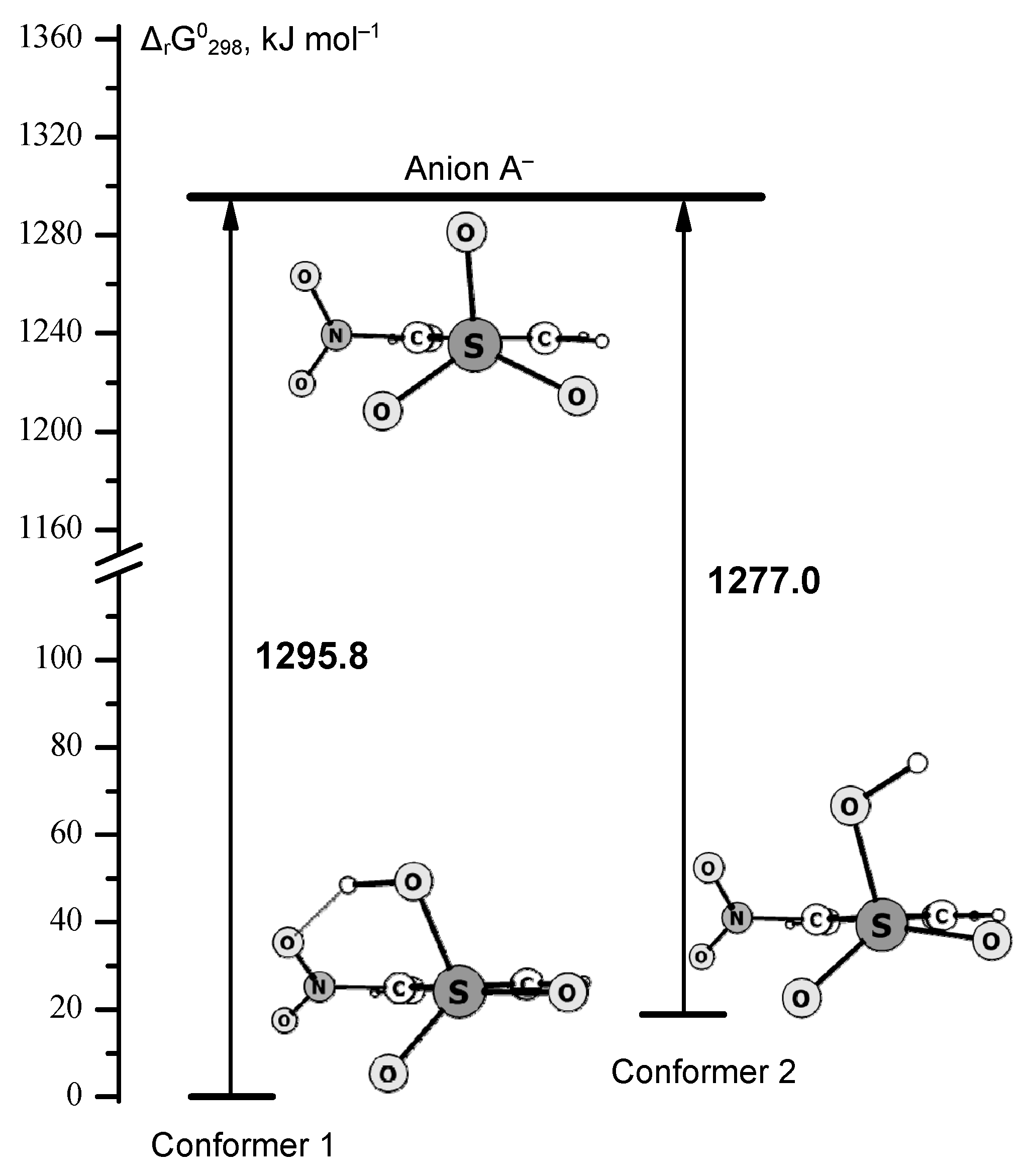
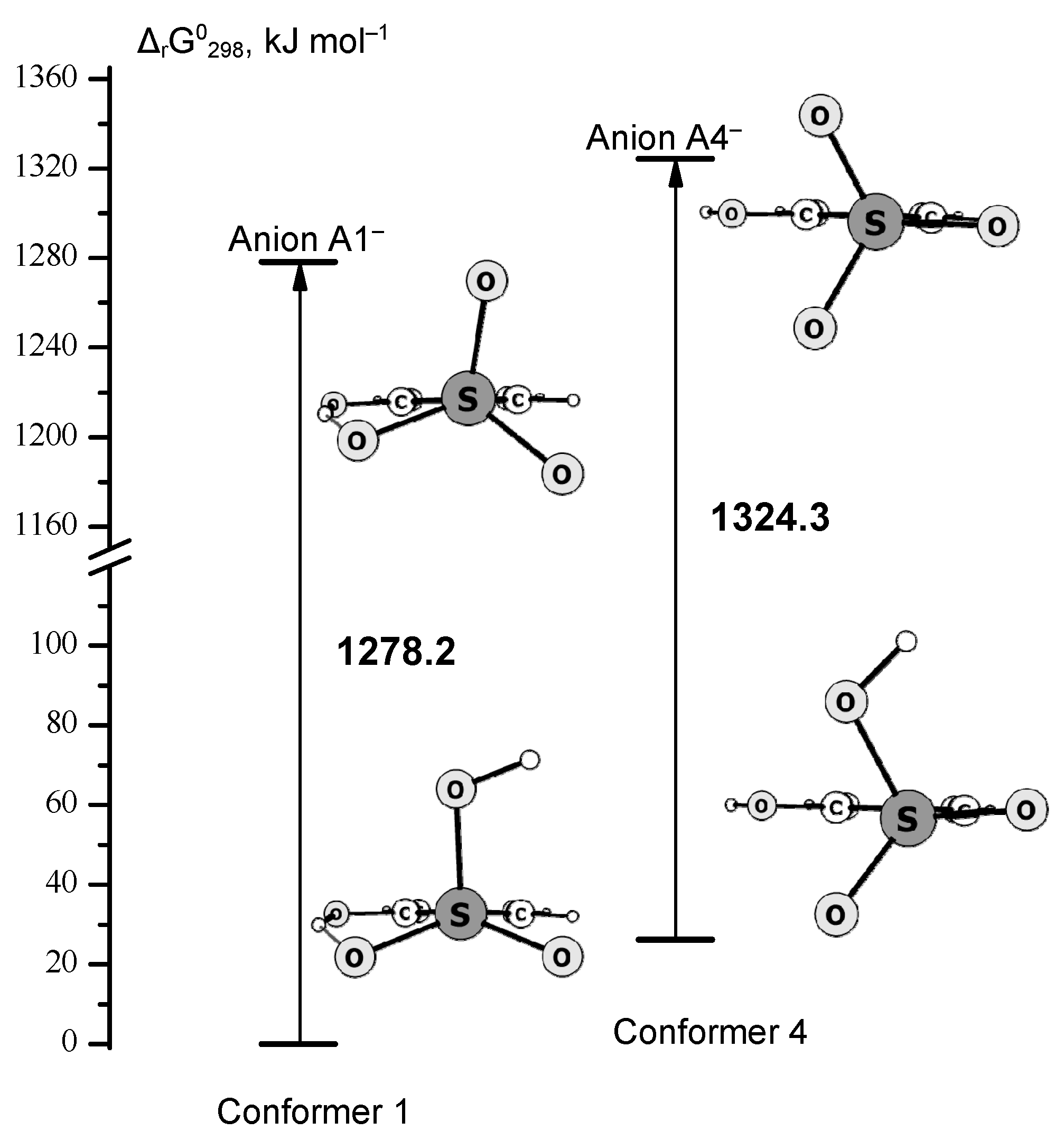
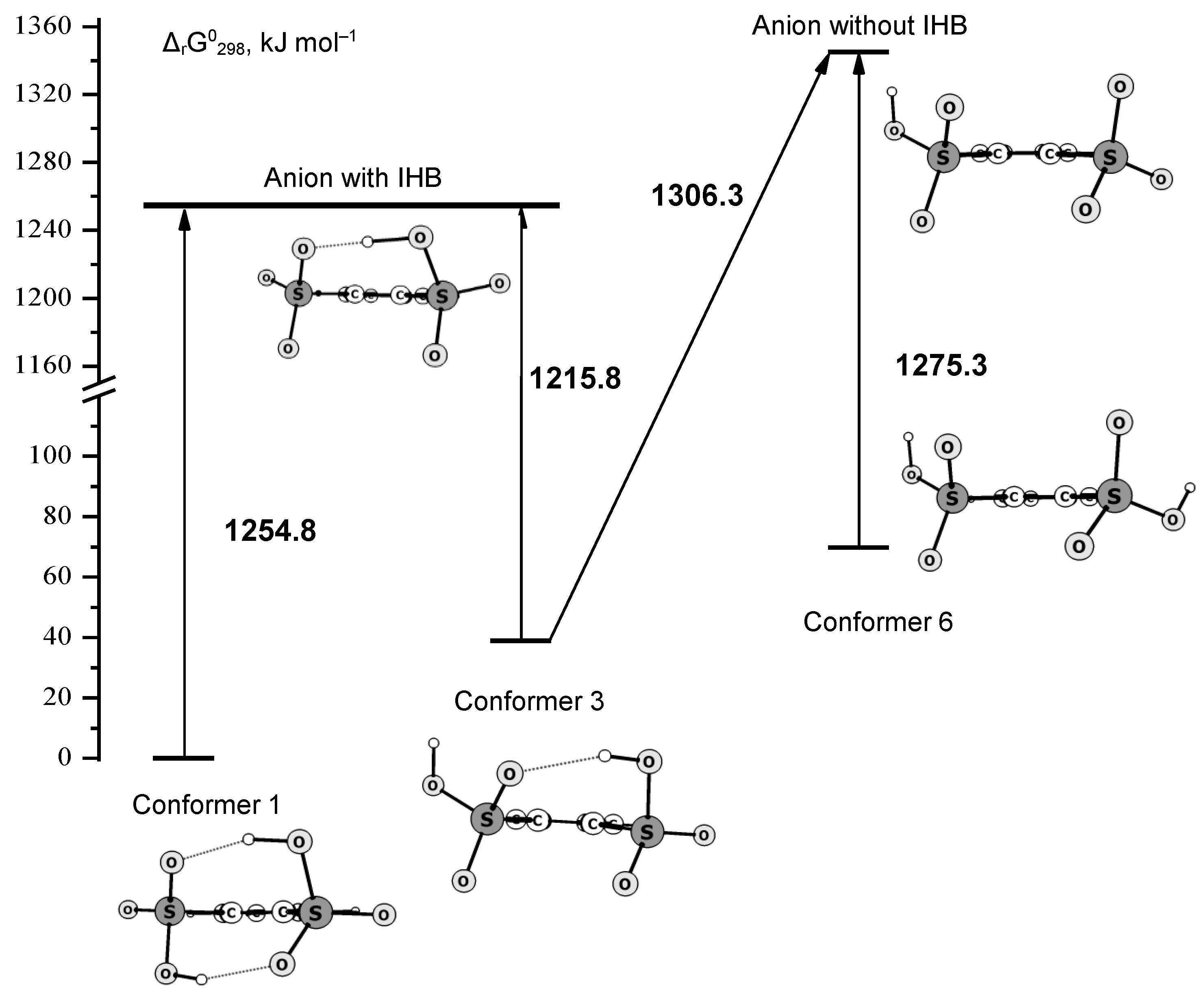
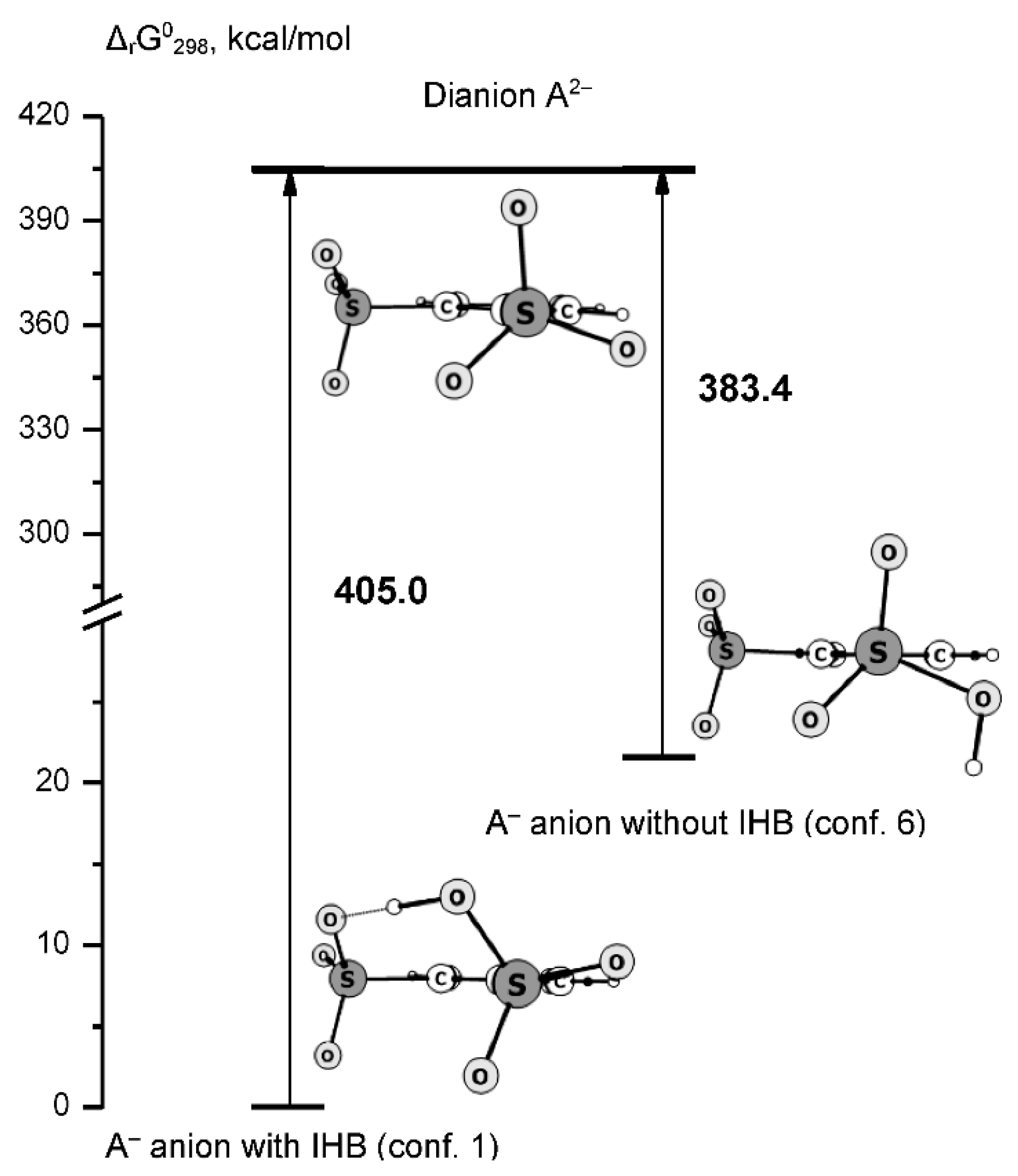
| Compound | Total Number of Conformers a | Number of Conformers with IHB b |
|---|---|---|
| BSA | 1 | - |
| 2-COOH-BSA c | 9 | 2 |
| 2-NO2-BSA | 5 | 1 |
| 2-SO2F-BSA | 9 | 4 |
| 2-CN-BSA | 3 | - |
| 2-NH2-BSA | 2 | 2 |
| 2-CH3-BSA | 3 | - |
| 2-OCH3-BSA | 3 | 1 |
| 2-N(CH3)2-BSA | 3 | 1 |
| 2-OH-BSA | 5 | 3 |
| 2-SO3H-BSA | 6 d | 3 |
| Acid (Conformer) | Molecule AH | Deprotonated Form A− | ||||||||
|---|---|---|---|---|---|---|---|---|---|---|
| r(D–H) | r(A···H) | r(A···D) | ∠D-H···A | ΣE(2) | r(D–H) | r(A···H) | r(A···D) | ∠D-H···A | ΣE(2) | |
| 2-NH2-BSA (1) | 1.009 | 2.064 | 2.857 | 133.8 | 17.2 | 1.020 | 1.915 | 2.700 | 142.0 | 41.4 |
| 2-OH-BSA (1) | 0.976 | 1.820 | 2.700 | 148.4 | 53.6 | 1.003 | 1.611 | 2.566 | 157.3 | 148.2 |
| 2-OH-BSA (2) | 0.977 | 1.791 | 2.680 | 150.0 | 61.5 | |||||
| 2-SO3H-BSA (1) | 0.992 | 1.728 | 2.670 | 157.0 | 82.1 | 1.061 | 1.412 | 2.466 | 172.0 | 506.6 |
| 2-SO3H-BSA (2) | 0.983 | 1.781 | 2.697 | 152.1 | 59.5 | |||||
| 2-SO3H-BSA (3) | 0.983 | 1.796 | 2.704 | 152.1 | 55.3 | |||||
| 1. The Acid Conformer AH and Conformer Anion A− do not Contain IHB | ||
| Acid | Conformer numbers | Anion |
| 2-COOH-BSA | 3–9, Figure 1 | Figure 11a |
| 2-NO2-BSA | 2–5, Figure 2 | Figure 11b |
| 2-SO2F-BSA | 5–7, 9 and 7, Figure 3 | Figure 12a,b accordingly |
| 2-CN-BSA | 1–3, Figure 4 | Figure 11c |
| 2-CH3-BSA | 1–3, Figure 6 | Figure 11e |
| 2-OCH3-BSA | 2,3, Figure 7 | Figure 11f |
| 2-N(CH3)2-BSA | 2,3, Figure 8 | Figure 11g |
| 2-OH-BSA | 4,5, Figure 9 | Figure 12e |
| 2-SO3H-BSA | 4–6, Figure 10 | Figure 12g |
| 2. The Acid Conformer Contains the IHB; the –SO3H Group is a IHB Donor | ||
| 2-COOH-BSA | 1,2, Figure 1 | Figure 11a |
| 2-NO2-BSA | 1, Figure 2 | Figure 11b |
| 2-SO2F-BSA | 1–4, Figure 3 | Figure 12a–c accordingly |
| 2-OCH3-BSA | 1, Figure 7 | Figure 11f |
| 2-N(CH3)2-BSA | 1, Figure 8 | Figure 11g |
| 2-OH-BSA | 3, Figure 9 | Figure 12e |
| 2-SO3H-BSA | 1, Figure 10 | Figure 12f |
| 3. The Acid Conformer Contains the IHB. The –SO3H Group is an Acceptor of the IHB; Anion Conformer Preserves this Connection | ||
| 2-NH2-BSA | 1,2, Figure 5 | Figure 11d |
| 2-OH-BSA | 1,2, Figure 9 | Figure 12d |
| 2-SO3H-BSA | 2,3, Figure 10 | Figure 12f |
| Acid/ Type of IHB | Without IHB Type 1 | With IHB | |
|---|---|---|---|
| –SO3H is IHB Donor Type 2 | –SO3H is IHB Acceptor Type 3 | ||
| ∆rG0298 | ∆rG0298 | ∆rG0298 | |
| BSA | 1313.0 | - | - |
| 2-COOH-BSA | 1294.1(4) a | 1320.9(1) b | - |
| 2-NO2-BSA | 1277.0(2) | 1295.8(1) | - |
| 2-SO2F-BSA | 1268.6(5) | 1291.2(1) 1286.2(2) 1282.8(3) 1270.7(4) | - |
| 2-CN-BSA | 1270.3(3) | - | - |
| 2-NH2-BSA | - | - | 1310.0(2) 1311.3(1) |
| 2-CH3-BSA | 1308.8(1) | - | - |
| 2-OCH3-BSA | 1320.5(3) | 1332.7(1) | - |
| 2-N(CH3)2-BSA | 1313.8(2) | 1333.1(1) | - |
| 2-OH-BSA | 1324.3(4) | 1331.4(3) | 1278.2(1) |
| 2-SO3H-BSA | 1 stage 1279.9(4) 2 stage 1605.2(4) | 1 stage 1306.3(3) 2 stage 1695.7(3) | 1 stage 1224.2(2) 2 stage 1695.7(2) |
| Conformer | 1 | 3 | 6 |
|---|---|---|---|
 |  |  | |
| (∆rG0298)I | 1254.8 | 1215.8 a 1306.3 b | 1275.3 |
| (∆rG0298)II | 1695.7 | 1695.7 | 1605.2 |
| ∑(∆rG0298) | 2950.4 | 2911.5 | 2880.5 |
Publisher’s Note: MDPI stays neutral with regard to jurisdictional claims in published maps and institutional affiliations. |
© 2020 by the authors. Licensee MDPI, Basel, Switzerland. This article is an open access article distributed under the terms and conditions of the Creative Commons Attribution (CC BY) license (http://creativecommons.org/licenses/by/4.0/).
Share and Cite
Giricheva, N.I.; Ivanov, S.N.; Ignatova, A.V.; Fedorov, M.S.; Girichev, G.V. The Effect of Intramolecular Hydrogen Bond Type on the Gas-Phase Deprotonation of ortho-Substituted Benzenesulfonic Acids. A Density Functional Theory Study. Molecules 2020, 25, 5806. https://doi.org/10.3390/molecules25245806
Giricheva NI, Ivanov SN, Ignatova AV, Fedorov MS, Girichev GV. The Effect of Intramolecular Hydrogen Bond Type on the Gas-Phase Deprotonation of ortho-Substituted Benzenesulfonic Acids. A Density Functional Theory Study. Molecules. 2020; 25(24):5806. https://doi.org/10.3390/molecules25245806
Chicago/Turabian StyleGiricheva, Nina I., Sergey N. Ivanov, Anastasiya V. Ignatova, Mikhail S. Fedorov, and Georgiy V. Girichev. 2020. "The Effect of Intramolecular Hydrogen Bond Type on the Gas-Phase Deprotonation of ortho-Substituted Benzenesulfonic Acids. A Density Functional Theory Study" Molecules 25, no. 24: 5806. https://doi.org/10.3390/molecules25245806
APA StyleGiricheva, N. I., Ivanov, S. N., Ignatova, A. V., Fedorov, M. S., & Girichev, G. V. (2020). The Effect of Intramolecular Hydrogen Bond Type on the Gas-Phase Deprotonation of ortho-Substituted Benzenesulfonic Acids. A Density Functional Theory Study. Molecules, 25(24), 5806. https://doi.org/10.3390/molecules25245806








